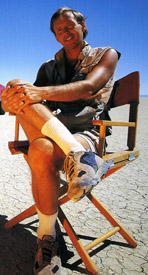Douglas
Keister

Memories
of the Phonograph
A Field Report
on Obsessive Phonograph Collecting Disorder submitted by
Douglas Keister HSD AAC
My first encounter
with this relatively rare (and under-reported) disorder was
when I first encountered the Boilesen Clan at their compound
at 544 Lyncrest Drive in Lincoln, Nebraska. The family appeared
normal; perhaps too normal. Mom (Betty), dad (Axel) son (Doug,
henceforth named DB) and sister (Bev) were right out of a textbook
for the perfect baby-boomer mix of occupations, avocations,
genders and ages. But the family held a secret; a secret that
was, at least for a time, kept in the cellar. As time went by,
the thing in the cellar crept up the stairs and slowly invaded,
then eventually took, over the entire household. Eventually
I too was infected.
Axel Boilesen became,
as time went on, my second dad. And he was, admittedly, a kinder,
gentler and more benevolent father that my own. He never ordered
me to mow the lawn, rake leaves, shovel snow or do any of a
host of disciplinary chores. He was perfect. DB was the perfect
brother. We never quarreled about ownership of sports equipment,
whose turn it was to do a multitude of household tasks or who
got to use the car. Bev and Betty somehow didnít figure in the
mix too often. Axel, DB and myself had manly duties to attend
to that did not require the participation or contributions of
females.
My first real phonograph
specific memory was when I was invited (or rather commanded
to go) into the Boilesenís cellar. What I encountered was hardly
a cellar in the traditional sense. Basements in Lincoln were
consigned to workshops, laundry rooms, places to toss the kids
and temporary shelters when tornado sirens sounded. The Boilesenís
subterranean sanctuary was a grotto of religious reverence.
All manner of phonographs
were displayed on individual shrines, their importance carefully
marked according to age and historical significance. Smaller
items such as needles, wax cylinders and miscellaneous artifacts
were displayed in their own secure cases that could only be
accessed by the Boilesenís themselves. I believe there may have
been a special shrine to Saint Tom himself with an empty reliquary
awaiting the arrival of a shard from the Alpha phonograph or
perhaps a wisp of the saintís hair.
After I had exhibited
what was deemed the right amount of appreciation, reverence
and enthusiasm for the assorted paraphernalia (and this took
more than a few indoctrinations) I was invited to participate
in a HUNT. These expeditions occurred at selected and random
times during the year. It was impossible to tell when and where
they would be as they were a closely guarded secret among the
Boilesens. The only clue I ever had was that they would NEVER
be during a University of Nebraska football game, a sub-religion
to the phonograph cult. These hunts were always centered around
finding and securing rare and elusive phonographic items. Sometimes
lesser prey, such as duplicates of items they already had, would
be bagged to be used as a later time as barter items when visiting
shrines of other members.
The destinations
of these expeditions varied from rural estate sales, garage
sales, antique stores and basements of unsuspecting dowagers.
During these hunts I was advised not to compete with Axel or
DB, for they were seasoned hunters and could easily out maneuver
me if I spied a pristine Uncle Josh cylinder or an ancient emblem.
I was advised to bring along a few small coins and encouraged
to purchase shiny things made of chrome or plastic. I usually
came away with items like old suitcases, beer signs and ceramic
bedpans.
In the ensuing months
and years our friendship as well as my collection of polystyrene
discards grew. My memories of the phonograph are less about
hardware and more about people. The Boilesen phonographic collection,
while certainly impressive, will never be as formidable as the
bonds I feel with the Boilesen family.
